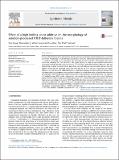Files in this item
Effect of a high boiling point additive on the morphology of solution-processed P3HT-fullerene blends
Item metadata
| dc.contributor.author | Long, Yun | |
| dc.contributor.author | Ward, Alexander J. | |
| dc.contributor.author | Ruseckas, Arvydas | |
| dc.contributor.author | Samuel, Ifor David William | |
| dc.date.accessioned | 2016-05-09T10:30:07Z | |
| dc.date.available | 2016-05-09T10:30:07Z | |
| dc.date.issued | 2016-06 | |
| dc.identifier | 240125316 | |
| dc.identifier | b587d735-158b-4bed-b975-21a1cf6191ec | |
| dc.identifier | 84955607221 | |
| dc.identifier | 000376809800004 | |
| dc.identifier.citation | Long , Y , Ward , A J , Ruseckas , A & Samuel , I D W 2016 , ' Effect of a high boiling point additive on the morphology of solution-processed P3HT-fullerene blends ' , Synthetic Metals , vol. 216 , pp. 23-30 . https://doi.org/10.1016/j.synthmet.2015.12.004 | en |
| dc.identifier.issn | 0379-6779 | |
| dc.identifier.other | ORCID: /0000-0001-9114-3522/work/32543056 | |
| dc.identifier.uri | https://hdl.handle.net/10023/8758 | |
| dc.description | Funding: UK Engineering and Physical Sciences Research Council (EPSRC) EP/L505079/1, EP/G03673X/1, EP/J009016/1 | en |
| dc.description.abstract | The use of high boiling point additives in solution processing has been widely employed to control the active layer morphology in bulk heterojunction organic solar cells. The morphology of the heterojunction is crucial in controlling charge separation and extraction by the electrodes, and therefore the power conversion efficiency (PCE) of the device. This paper presents a study of time-resolved fluorescence quenching in blends of P3HT containing varying concentrations of the fullerenes PC61BM or PC71BM. The relationship between the fluorescence quenching rate and fullerene concentration indicates that the fullerene molecules are dispersed within the P3HT film for up to 5% by mass of fullerene. For higher fullerene concentrations, the additional fullerene molecules aggregate and form fullerene domains. The high degree of phase segregation observed in these blends is beneficial for solar cell performance because the segregated fullerene phase provides electron percolation pathways through the blend. The addition of 1,8-diiodooctane (DIO) to the solutions for spin coating into films changes the scale of fullerene segregation when the ratio by mass of fullerene exceeds 20%. At high fullerene concentrations the rate of fluorescence quenching decreases in P3HT:PC61BM blends when prepared with DIO indicating a larger scale phase separation. The effect of DIO on the morphology of P3HT:PC71BM blends is the opposite in that it causes faster quenching in the blends. Overall the results show that DIO can be used to control the morphology of photovoltaic blends of P3HT with fullerenes. | |
| dc.format.extent | 8 | |
| dc.format.extent | 1080455 | |
| dc.language.iso | eng | |
| dc.relation.ispartof | Synthetic Metals | en |
| dc.subject | Organic solar cells | en |
| dc.subject | OPV | en |
| dc.subject | Conjugated polymers | en |
| dc.subject | Bulk heterojunction | en |
| dc.subject | Fluorescence quenching | en |
| dc.subject | Exciton harvesting | en |
| dc.subject | QD Chemistry | en |
| dc.subject | QC Physics | en |
| dc.subject | NDAS | en |
| dc.subject | SDG 7 - Affordable and Clean Energy | en |
| dc.subject.lcc | QD | en |
| dc.subject.lcc | QC | en |
| dc.title | Effect of a high boiling point additive on the morphology of solution-processed P3HT-fullerene blends | en |
| dc.type | Journal article | en |
| dc.contributor.sponsor | EPSRC | en |
| dc.contributor.sponsor | European Research Council | en |
| dc.contributor.institution | University of St Andrews. School of Physics and Astronomy | en |
| dc.contributor.institution | University of St Andrews. Condensed Matter Physics | en |
| dc.identifier.doi | 10.1016/j.synthmet.2015.12.004 | |
| dc.description.status | Peer reviewed | en |
| dc.identifier.grantnumber | N/A | en |
| dc.identifier.grantnumber | en |
This item appears in the following Collection(s)
Items in the St Andrews Research Repository are protected by copyright, with all rights reserved, unless otherwise indicated.

